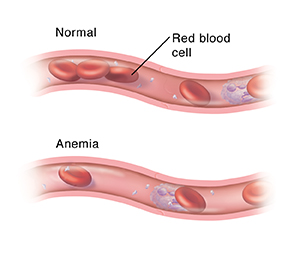Anemia
Anemia is a condition that occurs when your body doesn't have enough healthy red blood cells (RBCs). RBCs are the parts of your blood that carry oxygen all over your body. A protein called hemoglobin allows your RBCs to absorb and release oxygen. Without enough RBCs or hemoglobin, your body doesn't get enough oxygen. Symptoms of anemia may then occur.

What are the symptoms of anemia?
Some people with anemia have no symptoms. But most people have symptoms that range from mild to severe. Depending on the cause and severity of the anemia, symptoms can occur slowly or quickly. These can include:
-
Extreme tiredness (fatigue)
-
Weakness
-
Pale skin
-
Shortness of breath
-
Feeling dizzy or fainting
-
Fast or irregular heartbeat
-
Trouble doing normal amounts of activity
-
Yellowing of your eyes, skin, or mouth, and dark urine (jaundice)
-
Headache
-
Cold hands or feet
-
Chest pain
-
Pounding or whooshing sound in your ears
What causes anemia?
Anemia can happen when your body:
These problems can happen for many reasons, including:
-
A condition you are born with (congenital or inherited). This includes sickle cell disease or thalassemia.
-
Heavy bleeding for any reason. This includes injury, surgery, childbirth, or even heavy menstrual periods.
-
Being low in certain nutrients. These can include iron, folate, or vitamin B-12.
-
Some long-term (chronic) conditions. These include liver disease, diabetes, rheumatoid arthritis, or kidney disease.
-
Some chronic infections. These include tuberculosis or HIV.
-
Cancer.
-
Exposure to certain medicines. This includes chemotherapy medicines.
There are different types of anemia. Your healthcare provider can tell you more about the type of anemia you have and what may have caused it.
How is anemia diagnosed?
To diagnose anemia, your healthcare provider orders blood tests. These can include:
-
Complete blood cell count (CBC). This test measures the amounts of the different types of blood cells.
-
Blood smear. This test checks the size and shape of your blood cells. To do the test, a drop of your blood is looked at under a microscope. A stain is used to make the blood cells easier to see.
-
Iron studies. These tests measure the amount of iron in your blood. Your body needs iron to make hemoglobin in your RBCs.
-
Vitamin B-12 and folate studies. These tests check for some of the components that help give RBCs a normal size and shape.
-
Reticulocyte count. This test measures the amount of new young (immature) RBCs that your bone marrow makes.
-
Hemoglobin electrophoresis. This test checks for problems with your hemoglobin in RBCs.
-
Lactate dehydrogenase (LDH) and haptoglobin levels. These tests check the amount of substances in your blood called LDH and haptoglobin. Both LDH and haptoglobin levels can be abnormal with a type of anemia that destroys red blood cells (hemolytic anemia).
-
Bone marrow aspiration and biopsy. These tests are completed at the same time and evaluate the bone marrow where RBCs are made.
How is anemia treated?
Treatment for anemia is based on the type of anemia, its cause, and the severity of your symptoms. Treatments may include:
-
Diet changes. This includes increasing the amount of certain nutrients in your diet, such as iron, vitamin B-12, or folate. Your healthcare provider may also prescribe nutrient supplements.
-
Medicines. Certain medicines treat the cause of your anemia. Others help build new RBCs or ease symptoms. If a medicine is the cause of your anemia, you may need to stop or change it.
-
Blood transfusions. Replacing some of your blood can increase the number of healthy RBCs in your body.
-
Surgery. In some cases, your provider may do surgery to treat the underlying cause of anemia. If you need surgery, your provider will explain the procedure and outline the risks and benefits for you.
What are the long-term concerns?
If you have certain types of anemia, you can expect a full recovery after treatment. If you have other types of anemia (especially a type you're born with), you'll need to manage it for life. Your provider can tell you more.